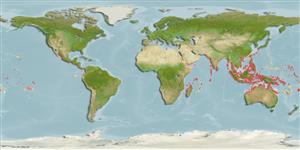Environment: milieu / climate zone / depth range / distribution range
экология
морской; пресноводный; солоноватоводный ассоциированный с рифами; dH range: 15 - 30; амфидромный (Ref. 51243); пределы глубины 0 - 15 m (Ref. 1602). Tropical; 23°C - 28°C (Ref. 13614); 30°N - 23°S
Indo-West Pacific: Red Sea and East Africa to the western Pacific.
Size / Вес / Возраст
Maturity: Lm ? range ? - ? cm
Max length : 400 cm TL самец/пол неопределен; (Ref. 3258); common length : 70.0 cm TL самец/пол неопределен; (Ref. 3258)
позвонки: 183 - 196. Brownish grey above, lighter below (Ref. 3257). Body moderately elongate, cylindrical in front, compressed along tail; eyes small; teeth small, biserial, inner series enlarged; head not obviously distinct from trunk although the profile is moderately steep; very large mouth, extending to well beyond eye; biserial sharp teeth on jaws, larger in front and in inner row; dorsal fin inserted on head before gill-opening; scales absent (Ref. 4832).
Inhabits muddy ocean bottoms (Ref. 6934) and estuarine areas (Ref. 2334), but sometimes found in rivers (Ref. 2334) and inner bays (Ref. 37816). Feeds mainly on a variety of small fishes and crustaceans. Known to extend itself vertically from a burrow with its head held horizontally beneath the surface, rising and falling with the tide (Ref. 9710). Marketed fresh and consumed locally (Ref. 3258). Solitary (Ref 90102).
Life cycle and mating behavior
половая зрелость | размножение | нерест | икра | Fecundity | личинки
Chen, H.-M., K.-T. Shao and C.T. Chen, 1994. A review of the muraenid eels (Family Muraenidae) from Taiwan with descriptions of twelve new records. Zool. Stud. 33(1):44-64. (Ref. 6934)
Статус Красного Списка МСОП (Ref. 130435: Version 2024-1)
Использование человеком
рыболовство: не имеет хозяйственного значения; объект спортивного рыболовства: да
дополнительная информация
инструменты
Специальные отчеты
Скачать в формате XML
ресурсы в Интернет
Estimates based on models
Preferred temperature (Ref.
123201): 25.5 - 29.3, mean 28.5 °C (based on 3263 cells).
Phylogenetic diversity index (Ref.
82804): PD
50 = 1.0000 [Uniqueness, from 0.5 = low to 2.0 = high].
Bayesian length-weight: a=0.00023 (0.00015 - 0.00035), b=3.13 (3.01 - 3.25), in cm total length, based on LWR estimates for this species & (Sub)family-body (Ref.
93245).
Trophic level (Ref.
69278): 3.4 ±0.46 se; based on food items.
устойчивость к внешним воздействиям (Ref.
120179): низкий, минимальное время удвоения популяции 4.5-14 лет (K=0.01).
Fishing Vulnerability (Ref.
59153): Very high vulnerability (90 of 100).
Nutrients (Ref.
124155): Calcium = 12.2 [5.3, 21.0] mg/100g; Iron = 0.313 [0.161, 0.702] mg/100g; Protein = 19.2 [16.9, 21.9] %; Omega3 = 0.0736 [, ] g/100g; Selenium = 52.2 [22.8, 125.0] μg/100g; VitaminA = 29.2 [6.0, 132.4] μg/100g; Zinc = 0.872 [0.561, 1.335] mg/100g (wet weight);
